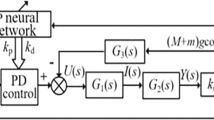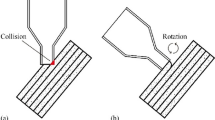Abstract
This paper presents a methodology and algorithm of optimizing and smoothing the laser head orientation control for 3D laser cutting. The frequent changes of laser head orientation in 3D laser cutting have a great impact on the cutting efficiency, operating safety and stability. Firstly, a kinematic model of 3D laser cutting machine is presented to obtain optional values of 5-axis motion coordinates at each cutter point when geometric information of cutter points on the cutting path is transformed to the motion coordinates of 5-axis. Considering the mass and inertia of two rotational axes as well as the friction between the moving parts, an energy consumption model of the 3D laser cutting between adjacent cutter points is established. With the objective of minimizing total energy consumption of B- and C-axis motion on the whole cutting path, the optimal cutting path can be found though the Dijkstra shortest path algorithm. The excessively big momentary swing of B and C rotation axes can therefore be avoided and the smoothness of the laser cutting is improved.
Similar content being viewed by others
References
Wang L, Hu G, Hu J, Luo J (2010) A new method to obtain discrete cutting points of space curve in three-dimensional laser cutting. Zhongguo Jiguang/Chinese J Lasers 37(6):1643–1646. doi:10.3788/CJL20103706.1643
Jin J (2001) Real time control of cutter orientation for machining surface-curve with multi-axis CNC machine-tool. Jixie Gongcheng Xuebao/Chinese J Mech Eng 37(3):85–88
Makhanov SS, Munlin M (2007) Optimal sequencing of rotation angles for five-axis machining. Int J Adv Manuf Tech 35(1–2):41–54. doi:10.1007/s00170-006-0699-8
Munlin M, Makhanov SS, Bohez ELJ (2004) Optimization of rotations of a five-axis milling machine near stationary points. CAD Computer Aided Design 36(12):1117–1128. doi:10.1016/S0010-4485(03)00164-7
Mudcharoen A, Makhanov SS (2011) Optimization of rotations for six-axis machining. Int J Adv Manuf Tech 53(5–8):435–451. doi:10.1007/s00170-010-2864-3
Gray PJ, Bedi S, Ismail F (2005) Arc-intersect method for 5-axis tool positioning. CAD Comput Aided Design 37(7):663–674. doi:10.1016/j.cad.2004.08.006
Hosseinkhani Y, Akbari J, Vafaeesefat A (2007) Penetration-elimination method for five-axis CNC machining of sculptured surfaces. Int J Mach Tools Manuf 47(10):1625–1635. doi:10.1016/j.ijmachtools.2006.11.002
Pandey AK, Dubey AK (2013) Multiple quality optimization in laser cutting of difficult-to-laser-cut material using grey-fuzzy methodology. Int J Adv Manuf Tech 65(1–4):421–431. doi:10.1007/s00170-012-4181-5
Kondayya D, Krishna AG (2013) An integrated evolutionary approach for modelling and optimization of laser beam cutting process. Int J Adv Manuf Tech 65(1–4):259–274. doi:10.1007/s00170-012-4165-5
Jimin C, Yang J, Zhang S, Zuo T, Guo D (2007) Parameter optimization of non-vertical laser cutting. Int J Adv Manuf Tech 33(5–6):469–473. doi:10.1007/s00170-006-0489-3
Xu H, Huang Y, Yang X, Li Y (2009) Algorithm optimization for gesture of workpiece in 5-axis laser quenching of free form surface. Zhongguo Jiguang/Chinese J Lasers 36(2):487–493. doi:10.3788/CJL20093602.0487
Chen J, Xu Z, Zhong T, Jiang H (2002) Analysing kinematic and dynamic properties of a machine tool along curved tool path in high machining. Jixie Gongcheng Xuebao/Chinese J Mech Eng 38(1):31–34+62
Jimin C (2002) Automatic programming for 3-D laser edge-cutting [J]. Manuf Technol Mach Tool 2:011
Dolgui A, Pashkevich A (2009) Manipulator motion planning for high-speed robotic laser cutting. Int J Prod Res 47(20):5691–5715. doi:10.1080/00207540802070967
Crauser A, Mehlhorn K, Meyer U, Sanders P (1998) A parallelization of Dijkstra’s shortest path algorithm. In: Brim L, Gruska J, Zlatuska J (eds) Mathematical Foundations of Computer Science 1998, vol 1450. Lecture Notes in Computer Science. pp 722–731
Author information
Authors and Affiliations
Corresponding author
Rights and permissions
About this article
Cite this article
Xu, H., Hu, J. & Wu, W. Optimization of 3D laser cutting head orientation based on the minimum energy consumption. Int J Adv Manuf Technol 74, 1283–1291 (2014). https://doi.org/10.1007/s00170-014-6080-4
Received:
Accepted:
Published:
Issue Date:
DOI: https://doi.org/10.1007/s00170-014-6080-4




